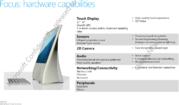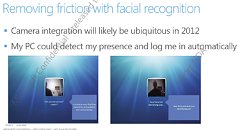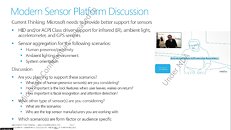- Joined
- Oct 9, 2007
- Messages
- 47,458 (7.50/day)
- Location
- Hyderabad, India
| System Name | RBMK-1000 |
|---|---|
| Processor | AMD Ryzen 7 5700G |
| Motherboard | ASUS ROG Strix B450-E Gaming |
| Cooling | DeepCool Gammax L240 V2 |
| Memory | 2x 8GB G.Skill Sniper X |
| Video Card(s) | Palit GeForce RTX 2080 SUPER GameRock |
| Storage | Western Digital Black NVMe 512GB |
| Display(s) | BenQ 1440p 60 Hz 27-inch |
| Case | Corsair Carbide 100R |
| Audio Device(s) | ASUS SupremeFX S1220A |
| Power Supply | Cooler Master MWE Gold 650W |
| Mouse | ASUS ROG Strix Impact |
| Keyboard | Gamdias Hermes E2 |
| Software | Windows 11 Pro |
Less than a year into the launch of Windows 7, and a few months in the making for its first service pack update, Microsoft has already taken large strides into outlining the key areas the company's next consumer operating system would focus on. Aimed to be released within the year 2012 time-frame (when Windows 7 will have become 3 years and 2 service packs old), Microsoft's next operating system is referred to as "Windows 8" (tada). The company had recently released to its industry partners a set of presentations, all covering different departments of the product's development, to outline the ideas in store for the developers. These confidential presentations were leaked to the public domain.
Among these presentations, some of the most interesting ones give us an insight on what interfacing with the PC will be like in a few years from now. To begin with, the average PC is poised to get a few mandatory updates to its hardware capabilities (just as how having a sound controller became mandatory for consumer PCs through the late 1990s). The PC will have a few sensors, cameras and accelerometers that will serve dual-purpose of user authentication and utility (use by software).



Devices such as infrared proximity sensors, accelerometers, ambient-light and web-cameras will let PCs detect its user nearby, verify the user's identity by face-recognition, and load-up (or unlock) the user's account on the PC. Later, the user can just walk away from the PC, and it will standby, hibernate, shut-down, or simply lock the PC and turn-off the display, to save power.
The operating system will be even more cloud-oriented, letting users access their profiles from any other cloud-enabled PC or device. Another major development would be the adoption of a major software and content delivery platform along the lines of Apple Store or Valve Steam, where users will be able to buy content and proprietary software. For now the medium is referred to as the "Windows Store". The same service will also handle software updates and the product service. These and more will form the key changes that are relevant to the consumer in Microsoft's next OS. Once the brainstorming is complete, Redmond will sit down to develop, test, fix, and release the operating system.
View at TechPowerUp Main Site
Among these presentations, some of the most interesting ones give us an insight on what interfacing with the PC will be like in a few years from now. To begin with, the average PC is poised to get a few mandatory updates to its hardware capabilities (just as how having a sound controller became mandatory for consumer PCs through the late 1990s). The PC will have a few sensors, cameras and accelerometers that will serve dual-purpose of user authentication and utility (use by software).



Devices such as infrared proximity sensors, accelerometers, ambient-light and web-cameras will let PCs detect its user nearby, verify the user's identity by face-recognition, and load-up (or unlock) the user's account on the PC. Later, the user can just walk away from the PC, and it will standby, hibernate, shut-down, or simply lock the PC and turn-off the display, to save power.
The operating system will be even more cloud-oriented, letting users access their profiles from any other cloud-enabled PC or device. Another major development would be the adoption of a major software and content delivery platform along the lines of Apple Store or Valve Steam, where users will be able to buy content and proprietary software. For now the medium is referred to as the "Windows Store". The same service will also handle software updates and the product service. These and more will form the key changes that are relevant to the consumer in Microsoft's next OS. Once the brainstorming is complete, Redmond will sit down to develop, test, fix, and release the operating system.
View at TechPowerUp Main Site
Last edited:








